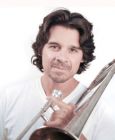Psychology
How Integrating Our Weaknesses Cultivates Musical Experience
Using Jungian psychology, we can enhance music experience.
Posted December 20, 2020

A distinctive characteristic of Eastern thought, and specifically that of Taoist wisdom, is the concept of dynamic balance. This is represented through the taijitu or yin-yang symbol. The swirl of dark and light is accented with the presence of its opposite in each half. The symbol is that of a wave rather than of linear division to illustrate the water-like fluidity of its nature. The symbol illustrates the dualist and monist nature of existence, which exists interdependently rather than discreetly. Whereas the Western worldview, informed by the Enlightenment tradition, tends to dissect and categorize nature based on differences, the Eastern worldview tends to understand the dynamic interplay that creates what we experience as opposites.
The analytical psychology of C.G. Jung is based on this Taoist principle of interdependence and wholeness. Through his study of both Western psychoanalysis and Eastern philosophical traditions, Jung described the psyche (soul) as a dynamic interplay between opposing forces. At the center of these forces is the anima and the animus, the dark and the light, which marks the core of our psychic structure. The goal of Jungian analytical analysis is to manifest individuation through the integration of psychic oppositions. In simple terms, one identifies one’s tendencies, that is to say one’s strengths, and makes a conscious effort to develop its opposite. An example of this might be encouraging a quantitatively-oriented person to cultivate their qualitative experience of life. Through the cultivation of the opposite, we come to balance and integrate opposing forces which ultimately results in individuation.
How can this be useful to us as musicians? By using Jung’s teachings based in Taoism, we can identify tendencies in our musical experience, cultivate their opposite, and achieve a more balanced musical experience. Ultimately, this balanced musical experience will extend beyond music and be a part of our experience of ourselves, others, and our world. I will tell you about two former music students to illustrate these ideas.
Stacy was a statistician for whom quantitative data was queen. Her natural tendency was to see the world discretely, in a binary style that could be easily columned and categorized. Putting things in order gave Stacy great pleasure and she was good at it; so good that she made it her profession.
Jerome, on the other hand, was what we call a Romantic artist. His life was governed by feelings and emotions, and his strength was in being acutely sensitive to these experiences. He had mastered the ability to put these feelings down in images, and to share these qualitative states with others through his painting. For Jerome, the emotional, intuitive world was king. He had cultivated his art and had managed to make a life from his way of experiencing the world.
For Stacy, thinking and judging shaped her worldview. For Jerome, it was feeling and perceiving. Stacy’s tendency towards sensing the empirical world was contrasted by Jerome's intuitive experience. Both had gravitated and cultivated a life based on their natural tendencies, which was experienced by them as their "strengths." These strengths are seen by others as characteristics that identified who Stacy and Jerome are. They too came to experience and understand themselves through these strengths and weaknesses. Strengths felt safe and weaknesses felt like vulnerabilities.
Work in projective tests, such as the Rorschach inkblot test, suggests that quantitative types and qualitative types see the world differently. Stacy might describe minute aspects of an inkblot in a lengthy and detailed way. Jerome might give a brief, dramatic general impression of how an inkblot strikes him emotionally; each experiences the world in a different way. This can also be observed in their respective musical tastes. Stacy was drawn to works by J.S. Bach and Mozart, whereas Jerome was more interested in improvisational jazz. When each of these students decided to study music, they both had a desire to make music, but they were unaware of how differently each thought of and experienced music. For Stacy, studying music had to do with precision, accuracy, and reading the score with accurate dedication. For Jerome, sitting down and improvising music that reflected his emotions was the goal. Each sought to cultivate something very specific to their lived experience.
Based on Jungian theory, we used the musical experience to help both of these students know themselves better. Having Stacy incorporate free-improvisational playing into her studies was a “scary” experience in which she came into contact with giving up the control, safety, and certainty of being told what to play by the composer. Having Jerome spend time daily reading through the musical sequences in Bach’s easier pieces was frustrating and at times aggravating for him. Each was cultivating the opposite of their natural tendency and in so doing, bringing greater balance to their musical experience as well as to life itself. Through the identification of our strengths and cultivation or our weaknesses we integrate aspects of ourselves that have been long ignored, in both our creative artistry and our experience of the world.


